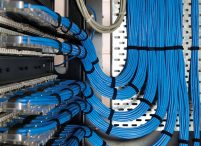Understand what structured cabling is and its importance. Whenever the term “structured cabling system (SCE)” is on the agenda, it is widespread that some doubts also arise on the part of IT managers, especially regarding investment and the importance of implementation.
Although this is a little-known topic among professionals in the field, the concept of structured cabling is essential for IT infrastructure planning. In fact, we are referring to an aspect that directly influences the support, safety and durability of the equipment.
If You are living in Southern California Contact STARLIGHT to discuss your needs, We would be happy to propose a solution
- Email: info@starlightcabling.com
- Phone: 949-434-4252
Want to know more about it? In this article, we will present everything you need to know about structured cabling, its benefits and the reasons to invest in this solution. Check out!
What is structured cabling?
Structured cabling is a standardized method of cabling a network, taking into account safety standards — such as ANSI and EIA / TIA —, best practices and the best use of equipment resources.
When we talk about a Structured Cabling System, we can immediately relate the idea to the network environment arranged with cables responsible for the integration of services (data and telecom), passing through some of the building’s facilities (entrance, telecommunications closet and equipment room, for example).
The ability to redirect through different paths within the same cabling structure so that different points can communicate is one of the main characteristics of structured cabling.
This concept emerged in voice technology services, however, it did not take long to become a solution to meet the most varied data services due to the great adoption by companies and the organization created through standardization.
How important is it?
How about we start this topic by proposing you a test? Try to imagine the following scenario: you are visiting a data center, owned by a highly regarded company, and you end up almost tripping over a cable installed halfway. On-site, you can see other cables exposed to a leak and wires running through the office desks.
Were you able to adapt the situation to real life? Of course not! In data centers it is practically impossible to come across this, after all, large corporations do infrastructure planning, with a view to complying with all technical standards (national and international) and the high performance of the machines.
In addition, structured cabling aims to ensure that the entire infrastructure project is fully capable of operating for a minimum period of 10 years, supporting, in addition to the processes, the servers of the local network, the number of switches, routers and their extension.
Why should your company also pay attention to these aspects?
Another crucial factor is flexibility and adaptation to changes. Information Technology is a sector in constant evolution and, with that, the emergence of new solutions that can be applied to business is something continuous.
However, the structured cabling system is designed precisely to support the implementation of new technology, as well as to considerably reduce its costs.
In short: a company that thinks this way and then invests in structured cabling guarantees not only security and prevention against technical problems, which can leave the system inoperable, but also that the infrastructure works in the long term and is ready to new technologies.
What to consider when implementing?
Given the importance that structured cabling has for the IT infrastructure, it is essential to hire a specialized company, registered with the Regional Council of Engineering, Architecture and Agronomy (CREA), and with credibility in the market to carry out this operation.
Before hiring, check that the service provider has manufacturer credentials and, if possible, consult with clients who have recently hired you.
Another relevant issue is attention to the electrical network and grounding. The electrical network must be dedicated and support all equipment connected to structured cabling, in order to ensure that the electrical network provides the necessary quality, given the conditions through which it will pass.
The grounding, in turn, must be aligned with the electrical network in order to provide all the necessary safety and protection, following ABNT standards.
It is also very important to assess the competence of the team of professionals that the company provides, especially regarding experience with structured cabling and the use of technical standards. It may seem obvious, but the suggestion is worth paying attention to the quality of the products used.
What are the main cabling standards?
Since we are talking about technical standards, we will use the hook to list the main standards that influence the implementation of structured cabling.
Note: most standards are international, therefore, they were created by renowned institutes and associations, such as the IEEE (Institute of Electrical and Electronics Engineers), TIA (Telecommunications Industry Association) and EIA (Electronics Industry Association).
Now let’s go to the most well-known physical norms :
- TIA/EIA-568-C.0 – Generic Telecommunications Cabling for Customer Premises;
- TIA 569-B – Commercial Building Standard for Telecommunications Pathways and Spaces;
- ANSI/TIA-606-A – Administration Standard for Commercial Telecommunications Infrastructure;
- ANSI/TIA-607-B – Telecommunications Grounding (Earthing) and Bonding for Customer Premises;
- ANSI/TIA-758-A – Customer-Owned Outside Plant Telecommunications Infrastructure Standard;
- ANSI/TIA-862 – Building Automation Systems Cabling Standard for Commercial Buildings;
- ANSI/TIA/EIA-1005 – Telecommunications Infrastructure Standard for Industrial Premises;
- TIA-942 – Telecommunications Infrastructure Standard for Data Center;
- IEEE-100BASE-TX – Fast Ethernet;
- TIA/EIA-568-C.3 – Optical Fiber Cabling Components Standard.
All these standards define the type of cable used, as well as the limits and requirements (distance, segments, frequency, etc.) that the structure must meet to ensure proper operation.
What types of cable can be used?
We have braided and fiber optic cables as the most used today, these being selected according to the business objectives, that is, the type of network we are dealing with.
The first of them, the braided one, is certainly the best known and “dominated” by computer specialists, especially because it is a cable used for many years for the implementation of networks. Among its biggest advantages, we can highlight the low cost and the ease of being purchased ready-made or made to measure.
On the other hand, we have the fiber optic cable, designed to meet a much more modern technology and which offers a series of benefits, starting with the fact that fiber optics is free from electromagnetic interference and, of course, the ability to work with high data transfer rates.
Still on fiber optic cable, it is worth noting that the trend towards the migration of this technology is very significant. Much of this is due to the Intelligent Brazil Program, launched by the Ministry of Communications, which foresees high investments with the objective of making fiber optic networks available to 75% of Brazilian municipalities.
Optical fiber, while offering many benefits, has the disadvantage of higher costs and the need for skilled labor. Therefore, choosing between traditional twisted cables and fiber optics is a matter strictly linked to the demands of the company.
We hope we have helped you understand the importance of structured cabling for businesses.
If You are living in Southern California Contact STARLIGHT to discuss your needs, We would be happy to propose a solution
- Email: info@starlightcabling.com
- Phone: 949-434-4252

